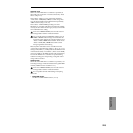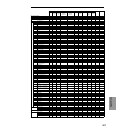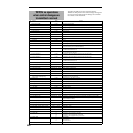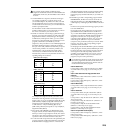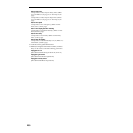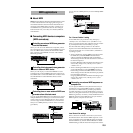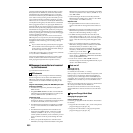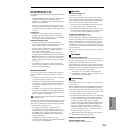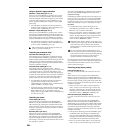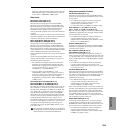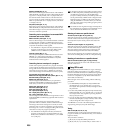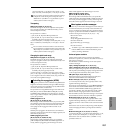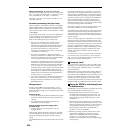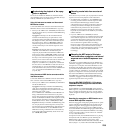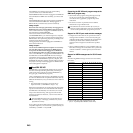
233
Appendices
Bank select MSB (CC#0) [Bn, 00, mm],
Bank select LSB (CC#32) [Bn, 20, bb]
(n: channel, mm: bank number upper byte, bb: bank number
lower byte)
• The internal banks that correspond to each bank select
number will depend on the “Bank Map” setting
(GLOBAL 1.1–2a). With the factory settings, this will be
GM. (☞p.124 “Bank Map”)
Simply receiving a Bank Select message will not cause
the program or bank to change. The program or bank
will actually change when a Program Change message is
received.
Program mode
• In PROG 1.1: Play, program change and bank select
messages are transmitted and received on the global
MIDI channel. These messages are not received in PROG
2.1: Ed–Basic – PROG 7.2: Ed–MasterFX.
Combination, Sequencer mode
• Program change and bank select messages can be
received on the MIDI channel specified for each timbre/
track to select programs on that timbre/track.
•When you select a combination, program change and
bank select messages will be transmitted by timbres
whose “Status” is EXT or EX2.
In Sequencer mode, program change or bank select
messages will be transmitted by tracks whose “Status” is
BTH, EXT, or EX2 when you select the “Program Select”
(SEQ 1.1–2(3)a), when you select a song, or when you
return to the beginning of a measure. (☞p.54 “Program
Select”–
)
• In Combination and Sequencer modes, transmission/
reception can be switched on/off for each timbre/track.
(☞p.41, 66 “Program Change”).
Selecting combinations
You can use program change and bank select messages to
select combinations in the same way that you select pro-
grams.
• Combinations 000–127 in banks A, B, and C correspond
to program changes [Cn, 00]–[Cn, 7F].
• Similarly as for program banks, the internal banks that
correspond to each bank select number will depend on
the “Bank Map” setting (GLOBAL 1.1–2a). (☞p.124
“Bank Map”)
• In COMBI 1.1: Play, program change and bank select
messages are transmitted/received on the global MIDI
channel. They are not received in COMBI 2.1: Ed–Prog/
Mixer – COMBI 7.2: Ed–MasterFX.
All program changes can be turned off in “MIDI Filter”
(GLOBAL 2.1–1b).
As needed, you can independently turn all program changes
on/off, specify whether or not incoming messages will be
able to change combinations, and turn reception/transmis-
sion of bank select messages on/off.
• If “Combi (Combi Change)” (GLOBAL 2.1–1b) is
unchecked, the combination will not change even if a
program change on the global MIDI channel is received
in COMBI 1.1: Play. In this case, the program of the
timbre that matches the MIDI channel of the received
message will change.
• If “Bank (Bank Change)” (GLOBAL 2.1–1b) is
unchecked, bank select messages will not be transmitted
or received (☞p.128 “MIDI Filter”).
After touch
Channel after touch [Dn, vv]
(n: channel, vv: value)
When you apply pressure to the keyboard after playing a
note, an after touch effect will be applied, and Channel After
Touch messages will be transmitted. When these messages
are received, an after touch effect will be applied.
• After touch for the entire TRITON Le can be turned off
in “AfterT (After Touch)” (GLOBAL 2.1–1b).
• In Combination and Sequencer modes, after touch can
be switched on/off independently for each timbre/track
(☞p.41, 66 “After Touch” COMBI/SEQ 4.1–1(2)a).
Polyphonic key pressure [An, kk, vv]
(n: channel, kk: note number, vv: value)
There is another type of after touch called Polyphonic Key
Pressure, which allows after touch to be applied indepen-
dently for individual keys. This message can be used as an
alternate modulation source, but cannot be transmitted by
the TRITON Le’s keyboard. In order to use this message, it
will have to be received from an external device, or recorded
on your sequencer.
The after touch mentioned in this manual refers to Channel
After Touch.
Pitch bender
Pitch bend change [En, bb, mm]
(n: channel, bb: lower byte of the value, mm: upper byte of
the value, together expressing a value of 16,384 steps where
8,192 [bb, mm = 00H, 40H] is the center value)
When this instrument’s joystick is moved in the X axis (left/
right), a pitch bend effect will be applied, and pitch bender
messages will also be transmitted. When these messages are
received, a pitch bend effect will be applied.
The range of pitch change that is produced by pitch
bend messages can also be adjusted via MIDI. (☞p.237
“Changing the pitch bend range”)
Control change
[Bn, cc, vv]
Transmitted and received as (n: channel, cc: control change
no., vv: value)
Refer to “MIDI transmission when the TRITON Le‘s control-
lers are operated” (☞p.224) and “TRITON Le operations
when control changes are transmitted/received” (☞p.228).
• Control changes can be turned on/off as a whole in “Ctrl
Change (Control Change)” (GLOBAL 2.1–1b).
• In Combination and Sequencer modes, the COMBI/SEQ
4.1–4.4: Ed-MIDI Filter 1–4 settings allow transmission/
reception of control changes to be individually turned
on/off for each timbre/track. For the assignable
controllers ([SW1], [SW2], REALTIME CONTROLS [1]–
[4] knobs, Foot Pedal/Switch), MIDI filter settings will
apply to the control change number to which each
controller is assigned. “Other Control Change” applies
to control changes that are not covered by the items of
the other check boxes (☞p.42, 68).
MIDI CC#00–CC#95 can be selected for the B-mode of
REALTIME CONTROLS [1]–[4] knobs.
Selecting program/combination banks
Bank select (CC#00, CC#32)
☞p.232 “Program Change/Bank Select”



